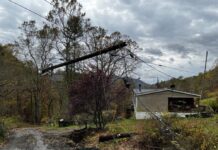I don’t often blog about someone else’s content, but today is an exception. On Sunday, I watched an interview on EMP attacks with Arthur T. Bradley, a NASA engineer, author, and prepping enthusiast, that ran on the Canadian Prepper’s YouTube channel. (If you want to watch the video, it is at the bottom of this article.) Kudos to the Canadian Prepper! I thought this was one of his best videos.
EMP vs CME
For those who don’t know what an EMP is, it is an electromagnetic pulse is produced by a nuclear detonation. The gamma rays from the nuke ionize the air molecules to produce positive ions and recoil electrons called Compton electrons. This burst of energy produces a powerful electromagnetic pulse that has the potential to damage or destroy electronic devices, especially those with antennas or long wires that can serve as antennas. It is generally taken for granted than an EMP would be picked up by our electric transmission lines and travel to the generation equipment on one end and the transformers on the other, destroying or damaging them.
If set off in space, not only would the pulse damage devices on the ground, but any satellite or other space-based systems in the line of sight that are not shielded against EMP would be destroyed.
I found the discussion of the differences between an EMP attack and a coronal mass ejection (CME) from the sun to be of particular interest. According to Bradley, a CME is unlikely to destroy smaller electronics, like phones and the chips in cars. (Of course, your cell phone might not do you much good if the cell towers are fried.) We should also have a couple days warning that a CME is headed our way.
His suggestion that you should switch off the main breaker in your house before a significant CME strikes was new information for me. Because a powerful current can sometimes jump a gap, I would turn off all the individual breakers AND the main breaker and then unplug every device I could. Appliances we depend on for preservation and preparation of food, like the refrigerator and freezer, would be the first on my list. (See below.)
Electricity: The Life Blood of Everything
As described above, and as any prepper worth their salt knows, an EMP attack could potentially take down large portions of the electrical grid, which Bradley rightly called “the life blood of everything.” This aftermath of this kind of attack is one of the main things I prepare for: Living life without electricity and electronic devices.
Many of us prepare for short-term power outages, but how many are prepared for an outage that lasts months or years?
We have a gravity flow water system that does not use electricty and we heat with wood, so we are as well prepared for a lengthy power outage as we can be. Even so, being without power will still mean a major lifestyle change.
an EMP would Knock us Back
I have discussed getting thrown back into the 1880s lifestyle and having to adapt to life without modern conveniences, appliances, refrigeration, lighting, transportation, communications, etc. An EMP strike would catapult us back to those living conditions, but we would lack the experience and infrastructure that allowed our ancestors to thrive. For example, most of us don’t have horses or a team of oxen, a buggy or wagon, an outhouse or a wood-fired cook stove. There are no stage coaches or steam ships; if we want to get out of dodge, we’ll need to walk or ride your bicycle. Better have a map; I expect the GPS satellites will be offline.
Do you have plans to survive without running water, without gas or electric heat or AC, without cars, without engines, without phones or TVs, without game consoles and computers, without refrigeration or grocery stores, and potentially without police, fire and EMS? How long can you feed yourself and your family? Preparing for an EMP should make you consider these questions.
Changes to my Plans
I have consumed a great deal of prepper literature, guides, videos, and blogs over the past 25 years, and it is not often that I come across something that makes me change my plans. This video did that. For example:
I have previously constructed Faraday cages out of large ammo cans, and I keep my portable walkie-talkie type radios, emergency AM/FM radios, and shortwave radios in there. After watchign this video, I am going to add a couple of my 18650 battery chargers and a few flashlights and headlamps in there. Most LED flashlights have a small circuit board inside. I don’t know if they would be fried in an EMP, but I don’t want to take that chance.
I am going to consider buying or building a larger Faraday cage to hold a laptop and tablet. While I am at it, I’m also going to look into building one for our generator, and possibly taking some steps to protect our cars.
I also prepared this preparation list for a CME, something I had not previously treated as a threat separate from EMP.
CME Prep List
- Turn off the main circuit breaker in the basement. The turn off all the other breakers.
- Unplug all electronic devices in the house. Don’t forget:
- Refrigerator
- Freezer
- Washer & dryer
- Stove
- Oven
- Microwave and toaster oven
- For electronics that have removable cords (like computers), disconnect the cord from the back. This includes disconnecting cable TV cables and phone lines from the modem and TVs.
- Disconnect all wires and dongles from televisions, laptops, and computers.
- Turn off and unplug uninterruptible power supplies and power strips.
- Disconnect the solar charger from electric fence
- Disconnect outdoor cameras
- Unplug solar lights from their panels
- Put cell phones, tablet, and thumb drives into the Faraday cage with the portable radios.
I would use the same list for EMP preparedness, but because we won’t get a warning about an EMP, it’s unlikely we’ll have time to use this list.
Video
Here’s the video. Get comfortable because it’s a full hour.









An easy faraday cage is a metal garbage can. Large enough size to toss some electronics in a duffle back and put into the metal garbage bin. Just make sure it is fully surrounded by metal. Keep on prepping!
Thanks, Adam. In the video, Dr. bradley says to seal the trashcan with metal tape or buy his expensive metallic gasket. On my ammo cans, I pulled off the rubber gasket, wrapped it in aluminum foil and stuck it back in there. It works, but you have to be careful things line up and the gasket doesn’t fall out when you close the lid.
Hi , I’m confused on how to keep my truck in working order if EMP happens , it’s new . Please help
Thank you
I am not an EMP expert, but let me list four things that I have heard people do to protect their vehicles from getting knocked out by a potential EMP. I believe these are listed in least protectvie to most protective, but someone else may be able to comment on that:
1. Park their car in an underground parking garage. I have no idea if this will work and it may depend on how deep the car is and other factors.
2. Store spare chips and electronic parts in a Faraday cage so any bad ones in your vehicle can be replaced after an EMP. I question if this is practical without 1) lots of car knowledge, and 2) because there are so dang many chips in cars these days. Chips are also expensive and may require some programming once installed.
3. Read up on EMP and vehicles at https://disasterpreparer.com/product-category/emp/ and buy one of their vehicle protection kits.
4. Go to the same site and buy enough EMP cloth to completely drape over your vehicle. This is probably the most effective method. Of course, it only works when your car is parked in a private area to which you control access. #3 will work if you are parked on the street, and maybe even if you are driving.
An alternative is to enjoy your new car and buy an old beater that does not have any computers in it. In 2004, the U.S. EMP Commission tested 50 vehicles built before 2002 against a moderate EMP pulse and all but 3 survived just fine. In some cases, it shut the car down, but then it restarted. My guess based on this research is you would be OK with anything built pre 2000, but ideally, you want a vehicle old enough to have a carburetor and not electronic fuel injection. If you buy a restored classic car, you could consider it an investment as well as a post TEOTWAWKI ride. Alternatively, I expect you could buy a 1999 Toyota Corrolla or a Honda civic for a few thousand dollars.
Like anything in prepping, your choice comes down to how likely you think a particular disaster is weighted against your wallet, balanced by a list of other preps you need to make and where you are in your prepping journey.
Hope that helps!
-Pete
Comments are closed.